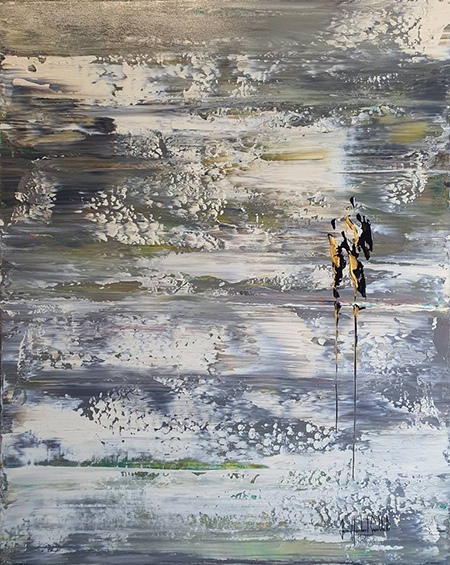Jean-Humbert′s unequivocal talents for using layered colors and vertical lines in his paintings are absolutely astounding and sensational. By brilliantly applying multiple mediums for his painting, he is able to depict intricate urban stories that resonate deeply with viewers. In his painting, we see human figures, separated by spaces, that are compressed into linear shapes representing the plight of modern people — isolation and loneliness. He mixes colors from his palette and builds up intriguing anecdotes that steer viewers into deep emotional plots. Then he develops the stories with his famed attention getters, vertical lines that guide viewers through each chapter. The vertical lines move fluidly throughout the paintings, creating sophisticated visual effects. Carving out multiple dimensions with his knife, he is able to build up conflicts and struggles which lead the stories to a climax. Each of his stories is a personal testament to a particular moment in time, be it prose or drama, leaving viewers with strong impressions that are hard to part with.
I am excited to be able to interview Jean-Humbert to learn about the training and development that led him to be a prolific and successful painter in the modern art world. His candid responses give us a glimpse of how he became who he is today. We hope you enjoy reading the following interview.t

Q: Your paintings are very unique with strong visual effects. Please share with us your training, especially the training you received at The School of Trompe-l′Oeil.
A: I began to learn painting in a decorative school, where I learned how to imitate matters like wood, marbles, etc. I also learned the basics of perspective, then I worked on panoramic.
I was painting with oil because it dries slowly and leaves time for the painter to work. For example, to paint cast shadows you have to reduce the intensity of the tint as things progress that the shadow moves away from its subject, acrylic painting dries too quick to permit that.
All these techniques need particular brushes and material. For wood you need to use combs, for marble you need to use double brushes, it′s a brush with a single handle and two brushes.
Sometimes you remove paint instead of adding more… this part will be very important for the way I paint currently.
The school of Trompe-l′œil is a very demanding school, you have to paint in hyper-realism style, and you must paint something in its right environment because the point is for people to believe it′s true.
It means that you must know perfectly what you are going to paint, but also the place you will paint it.
A good « Trompe-l′œil » is a painting that people don′t see… I mean, nobody can tell you « wow it′s amazing » because they think that the thing is real …
The real Trompe-l′œil is painting, for example, on walls, floors, or on the ceiling.. to be in situ.
If you paint on canvas it will be in the hyper-realism style and if you paint on canvas in the hyper-realism style something which can′t possibly exist, then it′s surréalism.
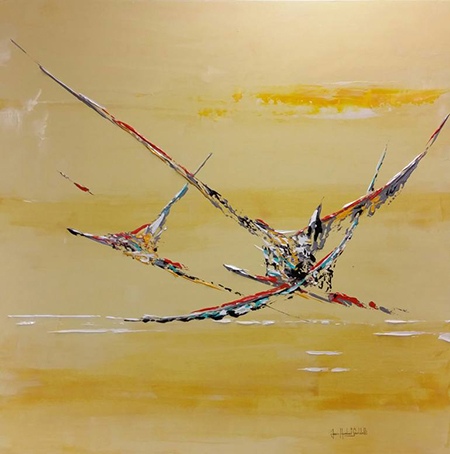
Q: Later, you developed your own style which helped you to carve out your own niche in the art world. Please tell us the transition you made and how it enhances your creativity.
A: The very famous painter Pierre Soulage said: the difference between an artist and a craftsman is that the craftsman knows where he is going.
I learned years later that he was right.
So when I began to paint on canvas I painted in the style I learned, which is you must first make a model and then apply it to the canvas.
I was again using oil painting.
Sometimes I tried to « be an Artist » that is to say to go directly to the canvas and let myself go, without preparing something, allowing my brushes to go where they want to go… but when you paint 15 years in the same way it′s not so easy to change, you have habits, techniques, and it′s just like a jail.
It seemed to me like evidence that if I wanted to change, I had to change everything, and I replaced oil, brush, and hyper-realism with acrylic, knife, and abstraction.
No model, no rule. I paint like I am. I mean I let my emotions guide my palette knives.
Q: What mediums or techniques do you use to create such a multidimensional look and feel in your paintings?
A: For that kind of artwork, I use acrylic and palette knives. When I start, I really don′t know what I′m going to paint, I just choose the colors and for that choice, it depends if I want to take risks or not. It depends on my desire to paint my desire to fight because painting is a fight…My signature is just like the signature of an armistice. People can′t see the fight in my painting. To see the fight they need to look at my palette, so they will be able to see whether or not I fought a lot. But nobody can see my palette. Is that so important? Only the painting remains and the spectator can interpret it as he wishes.
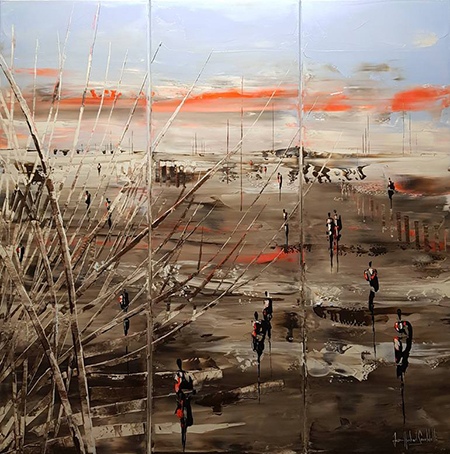
Q: What objectives do you seek when you paint? Is there any central theme that you gravitate towards?
A: When I paint I′m looking for elegance and poetry.
I think that′s why I use the vertical lines so much: for me, verticality is elegance, elegance is verticality. I′m not comfortable with circles and spheres. When I use them I′m rarely happy with the result. I painted around 900 works of art in this style and there are only three of them with spheres or circles.
Painting for me is just like a sentence. In a sentence you have a lot of words, I make short or long sentences: sometimes I use one ″word″, colored stripes, for example. Sometimes in another, I use KaligrafiK (those trickles of paint that form a convolution), sometimes I use sand mixed with glue and acrylic painting, and sometimes stripes made with a comb and for a few months, I also use the same word: the silhouettes which give to the artwork a figurative touch of humans.
On some canvases, I use one word, on others several words, on still others all the words that I know.
At the moment, I complete myself by painting abstract landscapes, which involve silhouettes. In some artworks it is the abstract that transforms into a landscape, thanks to the presence of the silhouettes… remove them and the painting will become entirely abstract.
Usually, I travel as the canvas is painted. The theme appears during the work; I never define a theme before painting.
Each painting has a name. The name of the artwork is very important for me as it is an integral part of the work.
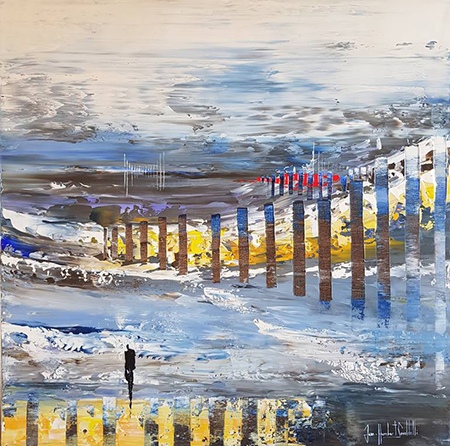
Q: The vertical and horizontal lines seem to play an important role in your paintings. Please share with us this technique and how you use it in your paintings.
A: As written up here the vertical stripes mean elegance to me.
The technique I used to paint them is a removal technique. I first apply the color of the stripes (for example, red), different kinds of red, then I paint the upper color, for example, green. I cover completely my first layer without mixing the two layers, and I remove parts of the second layer holding my knife vertically. If the removed part of the second layer is more important than the first layer, the painting will have a dominant color red. If the removed part of the second layer is thin, the dominant color will be green.
Everything has to be painted before the paint is dry otherwise it′s impossible to paint that way.
Q: If you don′t mind, please share with us your sources of inspiration.
A: I have no particular sources of inspiration. As I said, at the beginning I choose a harmony of colors that I want to work with, but my work evolves gradually and it may very well be that the final colors of the canvas are not at all that of the beginning.
During my work, I often sit back as a spectator, as if I′m not a painter. I′m then able to have a different opinion of what I paint and can take a different path.
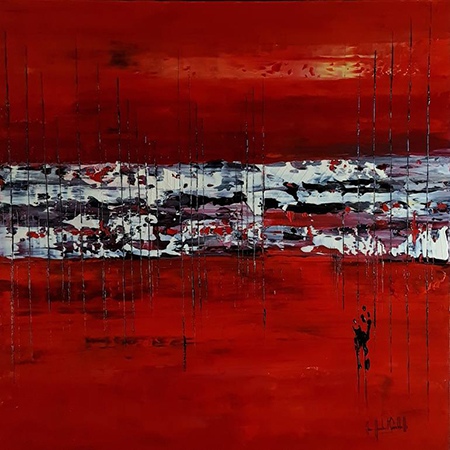
Q: Any thoughts on the recent lockdown due to the COVID 19 virus situation? Has it impacted you as an artist? If yes, how so?
A: Everybody has been impacted by the COVID 19 virus situation. Some people are looking for hope, others are going into depression. I′m in the first case.
Some of my artworks have been inspired by this period and painted in this period like « La pandemie du bonheur » but they are resolutely optimistic.
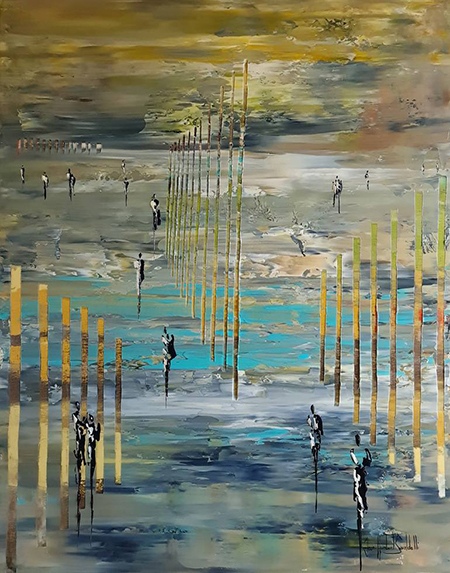
Q: Any future plans that you wish to share with our readers?
A: I don′t know if I will be able to change my way of painting, just like I changed already. I don′t know if it will be possible because there are so many things to explore and to invent with my way of painting.
The web galleries are a great way to show your art. It is obvious that if so many people have seen my works it is thanks to the collaboration with those galleries, in particular the Saatchi Art gallery. I will continue to collaborate with some of them.
I′m very happy to know that my paintings are seen by a lot of people in different countries and that my artworks leave France to go elsewhere in the world.
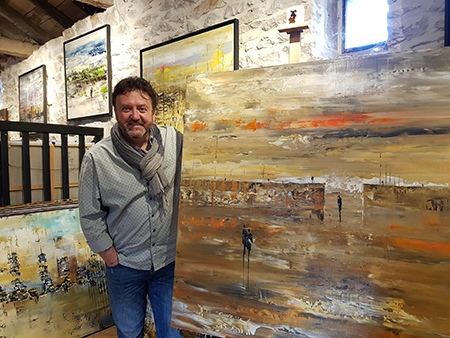
Jean-Humbert has successfully carved out a niche for himself in the competitive modern art world. His relentless drive for exploring in art mediums and presentations have made him who he is. If you are inspired by his words and art, please check out his page at the Saatchi Art site.
Jean-Humbert′s Website.
